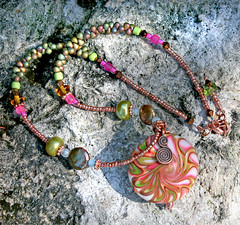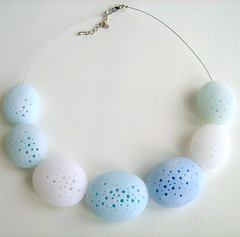For years I used Fimo polymer clay which is readily available here in the UK. Recently I found
Cindy Leitz and having read a lot on her blog and seeing her beautiful colour mixing recipes I decided I ought to try Premo clay. There are some discussions about brands on Cindy's blog
here. Being a fan of Donna Kato's work and having her excellent book I decided to try Kato polymer clay at the same time.
Here are some photos and notes about the different brands of polymer clay I tried;Kato, Premo, Fimo Soft and Fimo Classic.
First findings:
Kato - Very crumbly as it came out of the packet. Had to work it to warm it up before I was able to run it through the pasta machine. Firm, more difficult to shape. This polymer clay has quite a strong smell.
Premo - Very soft from the packet and was able to put it straight through the pasta machine. Soft to work with.
Fimo Soft (my normal brand) - Soft from the packet was able to put straight through the pasta machine. Very soft to work with.
Fimo Classic - I found this much the same as Fimo soft which surprised me. It wasn't quite as soft when first out of the packet but after being passed through the pasta machine a few times is was just as soft as the Fimo soft.
Flower Cane
First of all I made a Spliced Flower Cane in Blue, White and Green. I tried to keep the colours the same as possible but didn't go to great extremes of colour mixing (I'm not that good at it - yet!)
Kato, Premo, Fimo soft and Fimo Classic (from left to right)
The top row was a slice cut with a tissue blade just after the cane was finished and the bottom row is the same brands cut after a rest (overnight).
I realised that my blade wasn't as sharp as it used to be but this didn't seem to matter for the firmer Kato clay. I am sure I can improve my cane slicing technique (and I have also since bought a new blade).
I can see very clearly that it pays to leave your clay to cool down before slicing what ever brand you use. I know many people recommend putting it in the fridge for a while - I must try that.
Wow the difference shocked me - the Kato one (made in exactly the same way) looks very different. I accept there may have been a slightly larger area of white in the middle but even so the definition that the cane retained is far superior.
A closer view of the Premo and the Kato flower cane slices
Geometric Cane
I realised that the spliced flower cane wasn't a completely 'repeatable' cane so decided to make a simple geometric cane to see how that turned out.
From left to right Kato, Premo, Fimo Soft and Fimo Classic
Again top row was cut straight away and the bottom row was cut the next day.
As I was making them I thought the fimo looked different but couldn't work out why - hmm I realise now I only did half the job. Not sure what happened to the next day kato sample but needless to say it looked much the same, insignificant deformation.
Although the difference wasn't as marked as the spliced flower cane - I still much prefer the results of the kato. I like the feel of the baked kato too. The Kato white is more white and I think part of this is being firmer it stays cleaner.
A close up of the Kato and Premo canes
Conclusions
As I was working the spliced flower canes I thought I would prefer the Premo. I didn't like the work needed to condition the Kato clay and it was much firmer to work with even when thoroughly conditioned. The firmness is sometimes a disadvantage and sometimes an advantage. It was a disadvantage making the splice flower cane in the pinching the sides down. Also squashing the cane stacked quarters into a flat piece was quite physically demanding with the kato clay. At other times the firmness was an asset, cutting the bullseye canes into quarters was easier, less deformation. Things held their shape better and weren't floppy as they were with all the other brands at times. There was much less waste with the Kato et every stage. Even making skinner blends there was less waste from the Kato as it distorted less.
It is very much a personal preference and all sorts of things will effect your choice from where you live (temperature and also I gather some of the brands have slightly different formations in the states to UK), how you buy your clay (I have to buy Kato online can't get it in any local shops in the UK), the strength of your hands, what you like to make, how you work etc. Also if you don't want to mix colours the Kato range is rather limited.
However after I had seen the sliced and baked canes my mind was set - I'll give this Kato clay a go. I will probably invest in a little chopper to aid conditioning it isn't something I enjoy but I would say the results make that extra effort worthwhile.
I am currently wriritng an article on conditioning Kato clay having tried out several different ways - coming soon.....
(when I first set up this blog I didn't understand how it worked and made this as a separate page. I have decided to post it here too in case people missed it on the other page - there are some comments on the separate page version which I can't or at least don't know how to copy over)


























